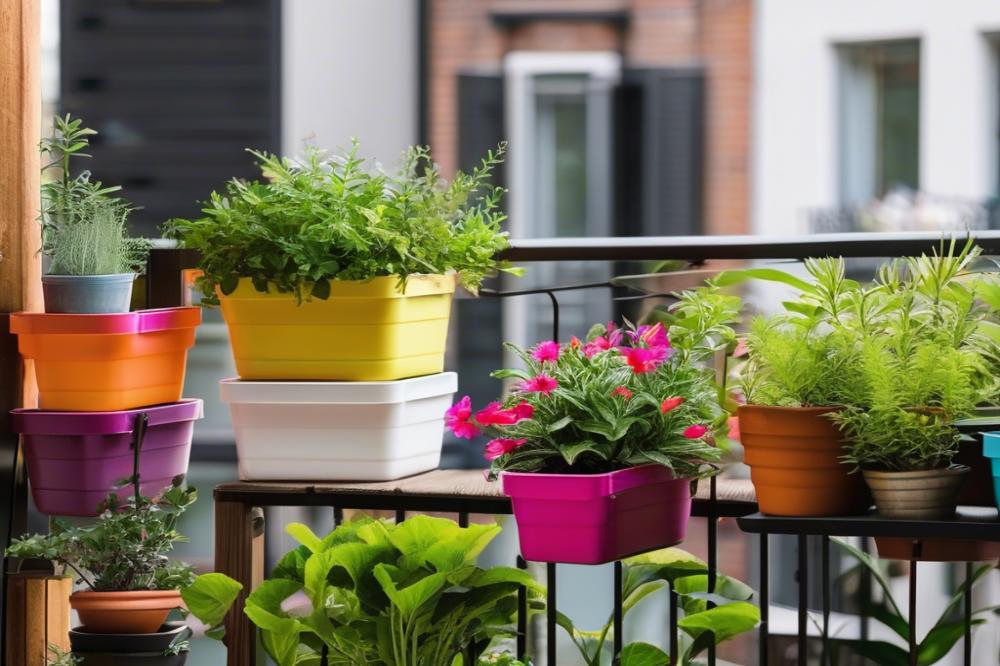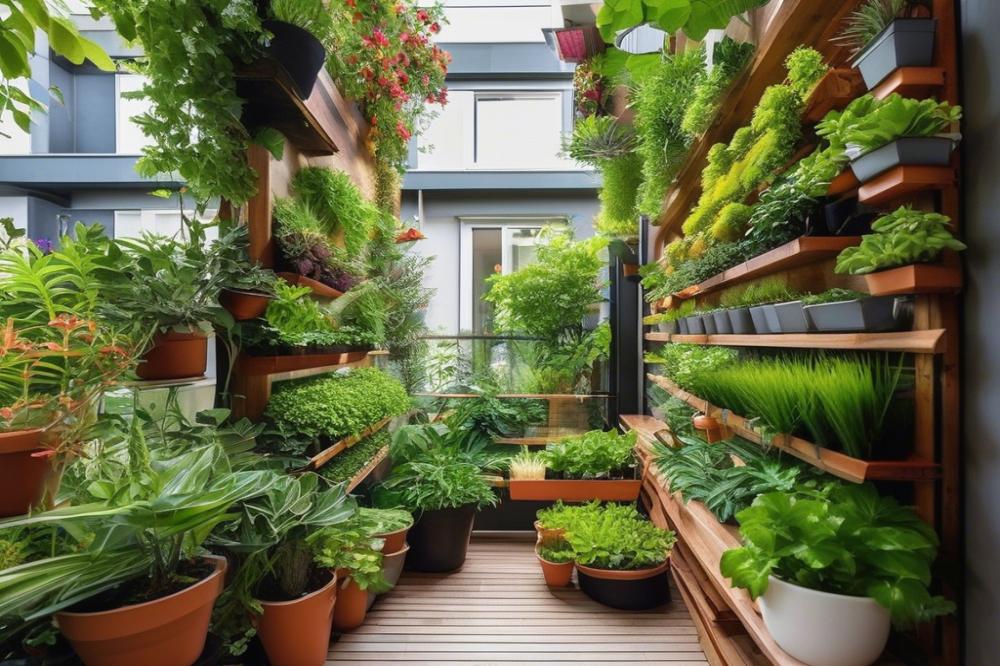Choosing the Right Containers for Your Small Space Garden
small space gardening presents a wonderful opportunity for those living in urban environments. With limited room, many people are finding joy in gardening-solution”>container gardening on balconies, porches, or windowsills. This method allows individuals to cultivate various plants, from vibrant flowers to flavorful herbs, without needing a traditional garden plot.
Picking the right containers is crucial for success. The right pots and planters can dramatically affect plant health and growth. Spaces often dictate the types of containers used. Selecting space-saving options, such as vertical gardening systems, maximizes the area you have while enhancing plant aesthetics. Innovative DIY containers can also be a fun way to personalize your garden.
Throughout this article, important gardening tips will be covered. You’ll learn about soil requirements for different plants, how to choose the best containers, and ways to design an attractive balcony garden. This guide aims to equip you with the knowledge needed to flourish in your small space gardening adventures.
Understanding Small Space Gardening


Small space gardening allows people to grow plants in limited areas, like balconies or tiny backyards. This method is growing in popularity as urban spaces become more crowded. It’s essential for anyone looking to introduce greenery into their homes. A few pots or planters can transform a dull corner into a thriving garden.
Common characteristics define these gardens. They often include containers, vertical gardening setups, and even window boxes. Many gardeners utilize DIY containers made from recycled materials to save money and space. Areas designated for herbs can flourish alongside flowers and vegetables, making the most out of compact environments.
urban gardening brings many benefits to communities. Growing your own food, even on a balcony garden, contributes to the health of your diet. Additionally, small gardens can improve mental well-being. Watching plants grow can provide a sense of accomplishment and joy amidst the hustle and bustle of city life. Using space-saving techniques allows gardeners to maximize their yield while maintaining a manageable workload. With proper soil requirements and some gardening tips, anyone can achieve a lush environment.
Types of Containers for Small Space Gardening
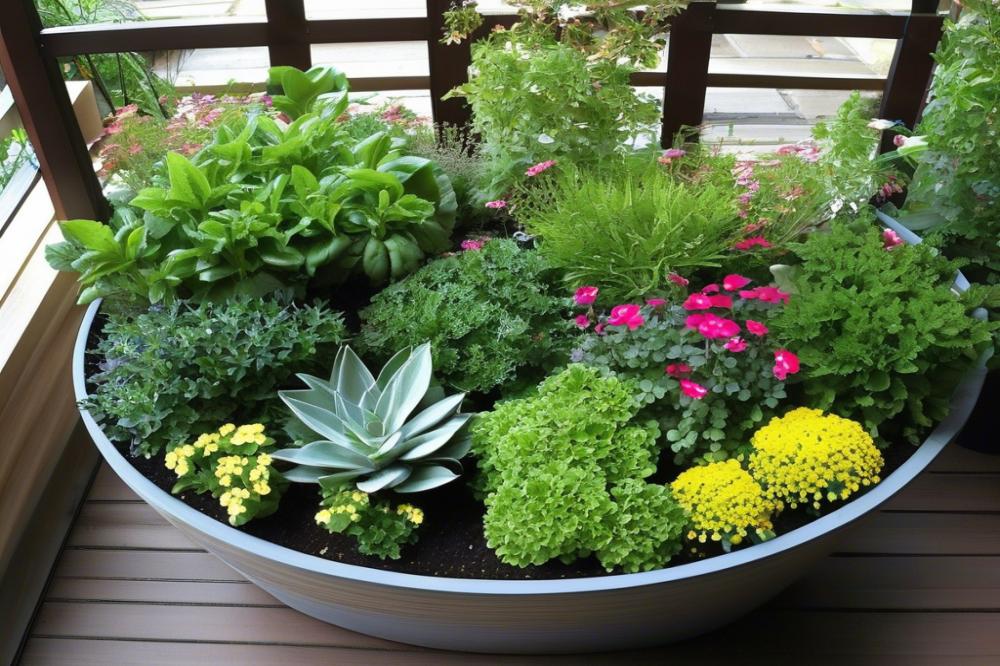

Choosing the right containers can make a big difference in your gardening experience. You will find various options available, including pots, planters, and even DIY containers. Pots usually come in a multitude of sizes and shapes. Planters can be larger and often serve multiple plants. For those who enjoy hands-on projects, you might consider creating your own DIY containers from materials like wood or repurposed items.
Comparing Materials: Plastic, Clay, Metal, and Eco-Friendly Options
Next, let’s discuss materials. Plastic containers are lightweight and often affordable. They can retain moisture better than you might expect. Clay pots tend to be more decorative and allow for better airflow to roots. However, they can crack in harsh weather. Metal planters, including steel or galvanized options, offer durability and a stylish look. Still, they can heat up quickly in the sun, affecting your plants.
Eco-friendly options are gaining popularity. Containers made from recycled materials or biodegradable products not only look good but support environmentally conscious practices. Consider materials that suit your gardening style and urban gardening goals.
Considerations for Weight and Durability
Consider weight when choosing containers. Heavy materials might be challenging to move around, especially for a balcony garden or a rooftop setting. On the other hand, lightweight pots are easy to shift but may not withstand strong winds or heavy rain as well. Durability is also crucial. Look for pots that can handle the outdoor elements without degrading too quickly.
So, think about your particular needs. What plants will you grow? Herbs or flowers require different soil requirements and often thrive in various types of containers. Vertical gardening can also save space, allowing you to grow more even in limited areas.
Using different types of containers creatively can transform your area into a vibrant garden. Always explore your options and pick what helps you maximize your space. These choices can drive your gardening success and enhance your environment.
Choosing the Right Size and Shape
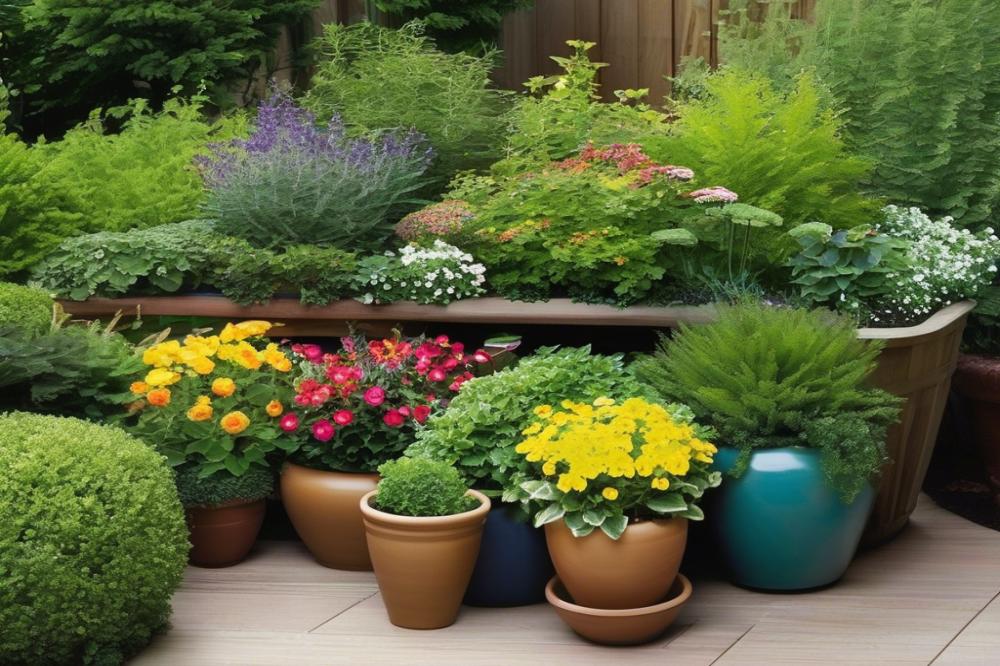

One of the most vital aspects of gardening in compact spaces is container size. Each plant has specific soil requirements and room to grow. A pot that is too small can stunt growth. On the other hand, oversized containers might waste precious space. Always consider how tall or wide a plant will get before picking a pot.
Space-saving shapes can greatly benefit urban gardening. Vertical gardening options like wall planters are clever solutions. They allow you to maximize your available area, making great use of vertical space. This method opens up opportunities to add more plants without cluttering your floor space.
When it comes to choosing between round and square containers, each has its perks. Round pots often have a classic look. They can fit into awkward corners easily. Square containers, however, can line up neatly against walls. Use them in your balcony garden to create structured rows. Think about where you want to place your planters and how they will fit into your overall layout.
For growing herbs, consider using shallow pots. This way, you match both size and depth to the needs of your plants. DIY containers can also come in handy. You can make them from recyclable items, giving your garden a personal touch. Just remember that each type of container suits various plants differently.
When exploring different shapes and sizes, remember to think about drainage. Tall, narrow pots can dry out quickly. A broader container, on the other hand, retains moisture better. Choosing wisely can mean the difference between vibrant herbs and wilting plants. Follow some gardening tips to find the perfect balance for your green space.
Vertical Gardening Solutions
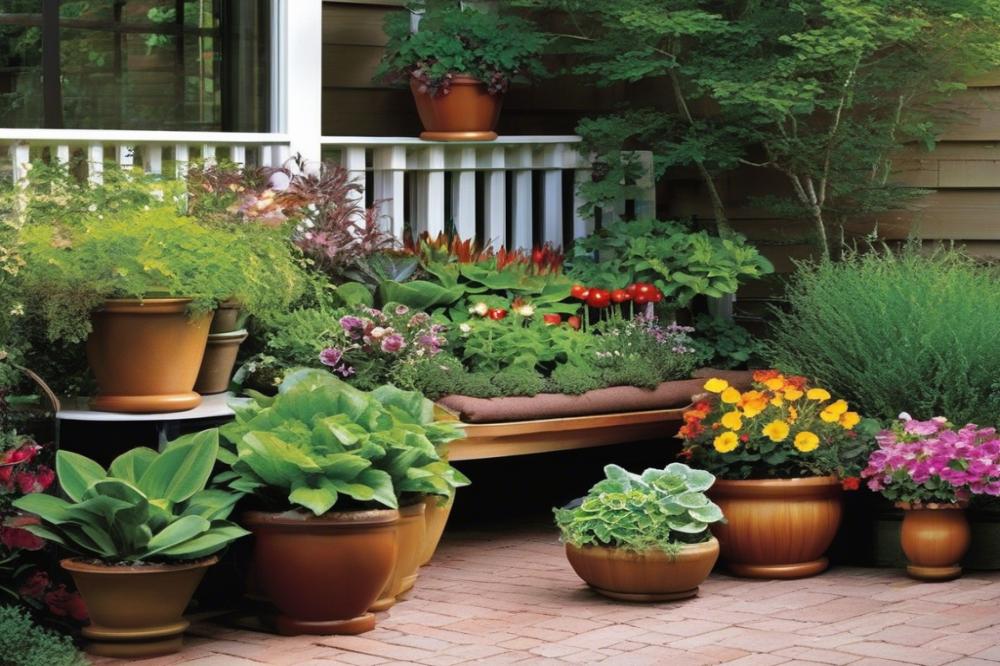

Vertical gardening opens up a world of possibilities for anyone dealing with limited space. Transforming walls or fences into green spaces allows you to maximize your growing potential. Besides, it adds charm to your urban gardening efforts. Fresh herbs or colorful flowers can thrive without taking up valuable floor area, making it ideal for apartments and balconies alike.
Benefits of Vertical Gardening in Small Spaces
One major benefit of this method is the ability to grow more in less. Healthy crops can be raised even in tight spots. Growing plants vertically helps improve air circulation, reducing the chances of mold and pests. A vertical setup can also act as a natural privacy screen, giving you some seclusion in a busy neighborhood.
Types of Vertical Planters and Wall-Mounted Containers
Various options exist when it comes to selecting vertical planters. Wall-mounted pockets made of felt or fabric create an attractive way to display your herbs. Alternatively, tiered planters stack pots on top of one another. Using a trellis can support climbing plants, helping them reach new heights. There are even wall grids designed to hold pots securely, creating an artistic touch.
DIY Vertical Gardening Projects
If you enjoy a hands-on approach, consider making your own vertical garden. You could repurpose materials like wooden pallets or plastic bottles to create unique containers. Hanging planters can easily be made from old kitchen pots tied with sturdy rope. As you work on your DIY containers, remember to plan for drainage. Proper soil requirements are key for healthy plant growth.
For those looking to be more adventurous, try building a vertical garden frame. This can hold various pots at multiple levels, ensuring each plant gets adequate sunlight. With a little creativity, you can craft a balcony garden that stands out. Explore gardening tips by looking online for more projects that suit your style.
Balcony Garden Essentials
Factors to Consider for Balcony Gardening
When planning a balcony garden, consider the amount of sunlight your space receives. Some plants thrive in bright light, while others do better in shade. Also, think about wind exposure. Balconies can be windy, and sturdy plants or protective barriers might be necessary. You must evaluate the weight limit of your balcony too; heavy pots can be a concern. Drainage is crucial in containers, so choose pots with holes to avoid water buildup. Remember that space can be limited, so select space-saving solutions wherever possible.
Choosing Containers That Fit Balcony Railings
Selecting the right containers is critical for maximizing your balcony’s potential. Look for planters designed to fit securely on railings. These options make use of vertical space and do not take up valuable floor area. Some pots come with clips or brackets to hold them in place firmly. Remember to use lightweight materials. Heavy planters can strain your balcony structure. DIY containers can be excellent if you want to customize sizes and styles. Be creative, and make your balcony garden truly yours.
Herbs and Plants Well-Suited for Balconies
A balcony garden can host a variety of plants. Herbs are ideal because they require less space and can grow in small pots. Consider basil, rosemary, or mint for their robust growth in confined areas. They add flavor to your meals and can thrive with minimal care. Flowering plants like petunias or nasturtiums bring color and joy without taking too much room. Additionally, consider vertical gardening methods. Wall-mounted pots can house trailing plants and create a lush environment above the ground. Each plant will have different soil requirements, so choose wisely based on what you want to grow.
Taking these elements into account will help you create a vibrant and productive balcony garden that reflects your style and makes the most of your space.
Maximizing Soil and Plant Health
Understanding Soil Requirements for container gardening
Soil plays a crucial role in growing healthy plants. In container gardening, using the right mix will promote strong root systems. Each type of plant has unique needs, especially herbs and vegetables. Consider factors like pH level and nutrient content. Knowing these will help you choose wisely.
Selecting the Right Potting Mix for Small Space Gardens
Picking the right potting mix is vital for urban gardening success. Many blends are available, but not all are suitable for pots or planters. A quality mix often includes peat moss, vermiculite, and perlite. This combination helps with water retention yet allows good drainage. Always read the labels and choose mixes that support your specific plants.
Importance of Drainage and Watering Techniques
Good drainage ensures roots don’t sit in water, which can lead to rot. Choose containers with holes at the bottom. If you’re making DIY containers, punch holes into the base for proper flow. Watering techniques are also essential. Overwatering is a common mistake. It’s better to underwater slightly than to drown your plants. Regularly check the soil’s moisture level. This will keep your balcony garden thriving.
By focusing on these aspects, you will foster a thriving garden. Efforts spent on soil and watering will yield plenty of rewards in your small space. Use gardening tips to make the most of your urban gardening journey.
Gardening Tips for Small Space Success
Maintaining plants in limited spaces can be challenging but rewarding. Start with choosing the right containers. Pots and planters can fit nearly anywhere. They come in various sizes, so look for options that suit your available area. Using hanging planters can maximize vertical gardening opportunities. This technique utilizes often-overlooked wall space, giving your plants room to thrive.
Opt for a mix of herbs in your garden. These plants are not only useful in the kitchen, but they also yield a lot in small areas. Growing basil, parsley, and cilantro can be quite productive. These herbs take up little space and can be used fresh in numerous dishes. Consider planting them in DIY containers if you don’t have traditional pots. This approach allows for creativity while maximizing your space.
When planning your gardening schedules, think about seasonal considerations. Some herbs grow well in cooler months, while others prefer the heat of summer. Timing your planting will help you enjoy a bountiful harvest throughout the year. Pay attention to soil requirements as well. The right mix encourages healthy growth and prevents root problems. Regularly checking your plants is a smart gardening tip. It’s easier to manage small issues before they become larger problems.
Even in a balcony garden, proper plant positioning is vital. This can help ensure each plant receives adequate sunlight. Tall plants should go at the back, while shorter ones can be placed in front. Rotating your pots occasionally allows all your plants to get sunlight evenly. Engage your family in this process; it’s a great way to spend time together.
Using vertical gardening methods can further enhance your limited space. Installing shelves or trellises allows climbers to grow upward rather than outward. This technique helps you create a lush look while keeping your garden organized. Remember, small adjustments can lead to fantastic changes in your garden’s overall health.
Wrapping It Up
Choosing the right containers for your garden can make a significant impact on your success. Remember, the size and type of pots you pick can cater to your plants’ needs and your available space. Lightweight materials are beneficial if you need to move your containers around. Also, consider drainage. It’s essential for keeping your plants healthy. Select pots that have holes at the bottom to prevent excess water buildup.
Don’t hesitate to try out different styles and designs. Experimentation is part of the fun in gardening. You might find that certain plants thrive better in hanging baskets, while others do well in vertical planters. Personalizing your space can create a mini oasis that reflects your personality. Each choice you make can enhance the overall atmosphere of your garden.
Small-space gardening opens doors to creativity and resourcefulness. The joy of nurturing plants in a confined area can be fulfilling. Urban gardening brings nature closer to you, even if you live in a bustling city. The process of watching your plants grow adds life to your environment and promotes well-being.
In the end, the beauty of gardening lies not just in the results but also in the journey. Make your garden a cozy retreat where you can unwind. Dive into the joy of growing, and let your small space flourish with life!

